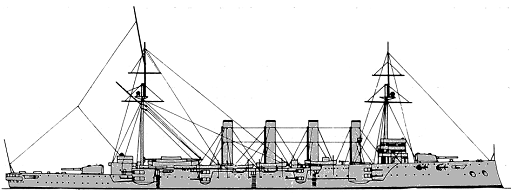

Drake 1905
| Name | No | Yard No | Builder | Laid down | Launched | Comp | Fate |
| Good Hope (ex-Africa) | P16 | 411 | Fairfield, Govan | 11.9.1899 | 21.2.1901 | 8.11.1902 | sunk 1.11.1914 |
| Drake | P09 | 235 | Pembroke DYd | 24.4.1899 | 5.3.1901 | 13.1.1903 | sunk 2.10.1917 |
| Leviathan | P28, P73, P1A | 343 | John Brown, Clydebank | 30.11.1899 | 3.7.1901 | 16.6.1903 | sold 3.1920 |
| King Alfred | P10, P98 | 277 | Vickers, Barrow | 11.8.1899 | 28.10.1901 | 22.12.1903 | sold 1.1920 |
|
Displacement normal, t |
14150 |
|
Displacement full, t |
|
|
Length, m |
152.4 pp 162.6 oa |
|
Breadth, m |
21.7 |
|
Draught, m |
7.92 |
|
No of shafts |
2 |
|
Machinery |
2 4-cyl VTE, 43 Belleville boilers |
|
Power, h. p. |
30000 |
|
Max speed, kts |
23 |
|
Fuel, t |
coal 2500 |
|
Endurance, nm(kts) |
7000(14) |
| Armour, mm | belt: 152 - 51, bulkhead: 127, decks: 64 - 25, turrets: 152, barbettes: 152, casemates: 127 - 51, ammunition tubes: 76, CT: 305 |
|
Armament |
2 x 1 - 234/47 BL Mk X, 16 x 1 - 152/45 BL Mk VII, 14 x 1 - 76/40 12pdr 12cwt QF Mk I, 3 x 1 - 47/40 3pdr Hotchkiss Mk I, 2 - 450 TT (sub, beam) |
|
Complement |
900 |
Project history: Provided under the 1898/99 Programme, these ships were enlarged versions of the Cressy class and were armoured cruiser equivalents of the Powerful class. Compared with the Cressys displacement was increased by 3000t to provide more powerful machinery (giving a 2kt increase in designed speed), four more 152mm guns and some minor improvements in protection. The four additional guns were accommodated by providing double-storey casemates amidships as well as at the ends. To reduce the amount of vulnerable target to a minimum, most of the midship structure, which formed the boat deck in earlier vessels, was omitted, cowl ventilators were replaced by windsails and all other fittings and structures above the upper deck were kept to a minimum. At the time of completion they were among the fastest ships in the world and proved to be good seaboats and exceptional steamers. On trials they exceeded their designed power by over 1000ihp but only Drake exceeded the designed speed by a substantial margin in making 24.11kts. They often exceeded their trial performance in service and for many years were capable both of running for long periods at high power and of achieving high power and of achieving high speeds.
Ship protection: The side armour was 152mm for a length of 78.4m amidships by 0.5m deep extending from the main deck to 1.5m below the waterline and then reduced through 102mm to 51mm at the bow, the thicker armour here being adopted in place of the forward armour bulkhead of the Cressy class. The belt was closed at the aft end by 127mm bulkhead. The protective deck was 64mm thick between the stern and after bulkhead and 25mm thick from the after bulkhead to the stem. Armoured tubes were provided to protect the ammunition hoists to the 234mm guns but these were not fitted for the casemate guns as the hoists were behind the side armour.
Modernizations: 1916, Drake, Ling Alfred, Leviathan: - 8 x 1 - 152/45 (in lower casemates); + 8 x 1 - 152/45 BL Mk VII (in shields on the shelter deck)
Naval service: Drake was 2.10.1917 torpedoed by German submarine U79 off Rathlin Island (Northern Ireland), drifted into Rathlin Sound and sank. Good Hope 1.11.1914 at the Battle of Coronel was destroyed by gunfire of German cruisers Scharnhorst and Gneisenau, exploded and sank with all hands.
Many thanks to Wolfgang Stöhr for additional information on this page.

Good Hope 1900s
© Ivan Gogin, 2008-14